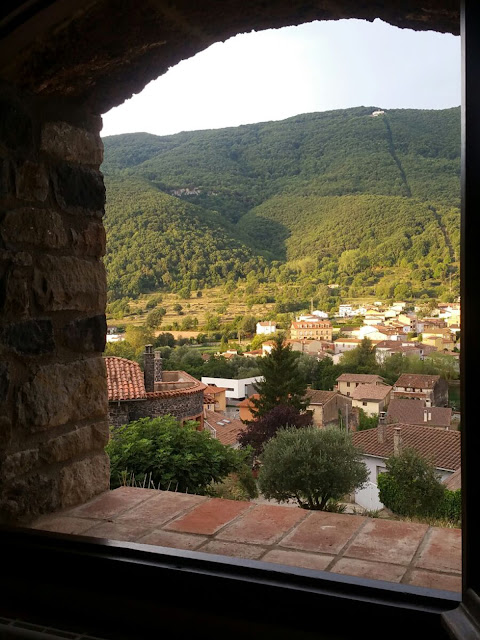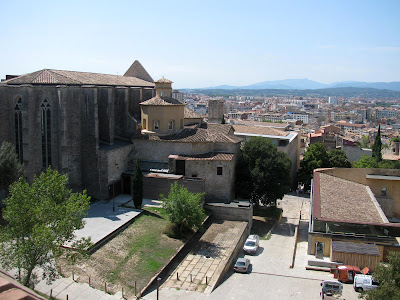After 5 busy days in Barcelona it was time to take it down a notch and move somewhere quieter. It has to be said that there was still plenty for
me to see and do in Barcelona, but the men in my family were growing a little tired of Gaudi and
Modernista architecture. Is that possible?
We drove north to the
Garrotxa county, an area known for the Zona Volcànica de la Garrotxa, a huge natural park with many extinct volcanic cones. We had booked an apartment in
Aiguabella, a beautiful manor house dating from the 13th century, set in the charming village of Sant Feliu de Pallerols. Aiguabella was built by local noblemen and each apartment is named after the house's 13th and 14th-century inhabitants. Our apartment was simply spectacular and we loved every minute of our stay there. The pictures above and below show the view we had from the apartment's windows, and look at the village itself. Just look at it!
The 8 nights we stayed in Aiguabella were meant to be for relaxing, swimming and generally unwinding, but honestly I am not very good at that! I relax when I am visiting unfamiliar and beautiful places. Each day we set out for somewhere new. We visited nearby Olot, the capital of the Garrotxa county, known for its natural landscape including four volcanoes scattered around the city centre. We climbed the steps up the
Montsacopa volcano, which has a circular crater produced by an explosive
strombolic eruption some 100,000 years ago. From the top we enjoyed the 360º panoramic views of Olot. The volcano also has a chapel on its top, built in 1817 and dedicated to
Saint Francis, and two watchtowers surrounding the crater. Later that same day we walked around the medieval town of
Santa Pau, built around a castle, with lovely views of the surrounding valleys.
Another day - the boys' absolute favourite day of the holiday - we drove to
Ribes de Freser and took the
rack railway up to
La Vall de Núria in the
Pyrenees. The railway climbs 12.5km over an incline of more than 1,000 metres through wild mountain scenery, and is the only way to access Núria's Valley. Stepping off the train, we were greeted with the most incredible views - and a sudden and unexpected heavy fall of rain and hail, which fortunately stopped just 10 minutes later! La Vall de Núria sits 3000 metres above sea level in a perfect little valley hidden from view, until the last moment, by the the mountains which completely surround it. In the centre of the valley is a hotel and exhibition centre, a picnic area, a lake and a small farm with animals. We soon left all this behind and set off on one of ten marked trails that climb above the valley. The words spectacular, stunning, awesome, breathtaking, beautiful and jaw-dropping spring to mind.
I knew that the
Call Jueu or Jewish quarter and medieval centre of
Girona was a must-see, so I booked a guided tour with Miquel at
Girona Trips for our visit to the city. Girona was once home to a large Jewish community.
Rabbi Moses ben Naḥman Girondi (better known as Nachmanides or Ramban) headed one of the most important
Kabbalistic schools in Europe here, but in 1492 the Jews were expelled from Girona and Spain as a whole. Girona also happens to be the place where some scenes from the 6th season of
Game of Thrones were filmed, and the men in my family are big Game of Thrones fans.
We met Miquel in front of the
Basilica of Sant Feliu and were soon exploring the old town. We saw the
Girona Cathedral, the old synagogues, the
Aljama and the Jewish quarter, the archaeological gardens and old city walls, and more. We also discussed quite a bit of football! Afterwards I visited
the Museum of Jewish History, a museum which allowed me a glimpse into Jewish life, both in Girona and in Spain
. The tour was a great success.
We had been told that the
Costa Brava is rugged and beautiful so set off for
Tossa de Mar on the southerly part of the coast, to see it for ourselves. The craggy rocks with the teal-coloured Mediterranean glimmering below were indeed gorgeous, but the beaches were absolutely packed with tourists and the English menus in the restaurants were not our thing! We quickly made our escape to the next beach up the coast. Maybe one day in the future we will travel further north and enjoy the unspoilt stretches of coast up there.
Modest, the friendly owner of Aiguabella, suggested a drive into the hills to enjoy the incredible views of the Garrotxa region from La Salut Catholic Sanctuary, located at the height of 1,028 metres, and the Sanctuary at El Far, positioned on top of some spectacular cliffs and overlooking the Montdois Plain and the
Susqueda reservoir.
And then it was our last full day. I can't say that I am the biggest
Salvador Dalí fan, but I wanted to experience the
Dalí Theatre-Museum in
Figueres, his birthplace, for myself. The Dalí Museum is officially called the Dalí Theatre-Museum because it is a renovation and expansion of the town's old theatre which Dalí knew as a child, and which was almost destroyed by a fire during the
Spanish Civil War. It holds the largest collection of major works by Dalí in a single location. In addition, a small selection of works by other artists collected by Dalí is housed there, and the second floor is dedicated to the work of his friend
Antoni Pitxot, who became the director of the Dalí Museum after Dalí died. Mister Handmade in Israel and the boys even opted to join me on this visit and we spent a good couple of hours at the museum. I’m glad we saw it. There is little doubt that Dali was a very unique and thought-provoking creator. But am I now a fan of Dalí's work? Erm, no.
Our final stop, before it was time to pack our bags, was
Besalú, a picturesque medieval town dating back to the 11th century. Famous for its impressive
Romanesque bridge which, unusually, is not straight but follows more of an 'L' shape to take advantage of rock in the riverbed, Besalú is also well known for its
mikveh, a ritual Jewish bath dating from the eleventh or twelfth century and thought to be one of only three left in Europe from that period. The mikveh anchors the remnants of the old Jewish quarter, as well as the remains of a medieval
synagogue, located in the lower town near the river. The Jewish population of Besalú thrived until 1415, when the authorities sealed the Jewish quarter, according to a plaque at the site. Within 20 years no Jews remained in Besalú and, by the end of the century, the
Spanish Inquisition was going strong and Jews and other "nonbelievers" were forcibly driven out of Catholic Spain.
The narrow cobblestone streets, restored medieval stone houses and small squares of Besalú were a treat. It was a great way to end our exploration of Catalonia. We loved La Garrotxa, the ever so slightly cooler weather, the chance to relax in a charming manor house, and also to delight in one or two good meals out (dinner at
Casa de Curry was yum!). Yet again, though there is so much of the world I would like to see, I hope we'll be back someday.


















































































































